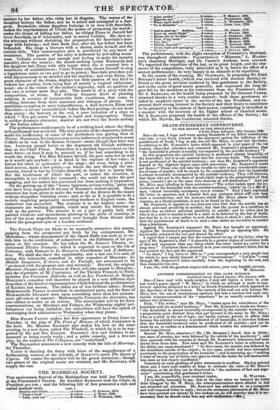DEATH-PUNISHMENT CONTROVERSY.
TO THE EDITOR OF THE SPECTATOR.
9 Felix Place. Islington, 19th January 1942. SIR—As one, I Lope and trust, among thousands of my fellow countrymen who take a very lively interest in the argument against the infliction of the punishment of death, I beg to ask, has not Mr. MILL, in your last Spectator, in referring to Mr. SAMPSON'S letter which appeared in your paper of the let instant, somewhat mistaken and misstated Mr. SAMPSON'S proposition, that "the homicidal is almost invariably accompanied by the suicidal tendency "? In this proposition the suicidal tendency is predicated almost invariably of the homicidal ; but it is not asserted that the converse holds. The homicidal is not predicated of the suicidal tendency ; nor does Mr. SAMPSON'S argument depend in the slightest degree upon such conversion. Mr. Saairsores words are these—" Those who will take the trouble to refer to any considerable num- ber of cases of murder, will be struck by the remarkable fact that the homicidal is almost invariably accompanied by the suicidal tendency. They will discover, that those who are in the state of mind which leads to the perpetration of that crime, [murder] are at the same time desirous of self-destruction." And yet Mr. MILL says, alluding to these sentences—. The writer insists upon the co- incidence of the homicidal with the suicidal tendency, 'which,' he [i.e. Mr. S.] says, 'almost invariably accompany EACH OTHER.'" Now I have reperused the letter in question, and I cannot find any sentence which will even bear such a construction; and the sentence which Mr. MILL places in inverted commas' as a literal quotation, is not to be found in the letter. Mr. SAMPSON, it appears to me, does not even hint that the suicide has an almost universal proclivity to murder ; but that the person in a condition to murder has an almost universal proclivity to suicide: and he infers that he who is in a state to murder is not in a state to be deterred by the fear of death, but that he is in a state rather to seek death than to shun it ; and, therefore, that the punishment of death is to such a man rather an incentive to murder than a hindrance.
Against Mr. Sestvsoses argument Mr. MILL has brought no argument. Against Mr. SAMPSON'S propositions he has brought no opposing fact. He has broadly misstated the one and abused the other. I regret that I cannot pay him the compliment to say of his letter, what he says of Mr. Sesirsoa's, that "it abounds in a greater degree of confusion both of fact and argument than any thing which has come under my notice for a long time." Confusion there certainly is in your correspondent's letter, but he has omitted the fact and the argument. " In short," I beg leave to offer to "your correspondent a very simple test by which be may satisfy himself of" his "incorrectness." "Let him "—read through Mr. Sesirsoses letter carefully from the beginning to the end, and then reconsider his own.
I am, Sir, with the greatest respect and esteem, your very humble servant, W. MILLER. ANOTHER CORRESPONDENT ON THE SAME SUBJECT.
Guildford Street, Russell Square, 18th January 1842.
Stn—I have read with much surprise, I may add regret, a letter in your last week's paper, signed " W. MILL," in which an attempt is made to con- trovert opinions advanced in a letter on Death-Punishment which appeared in the Spectator of the 1st instant. The warmth of his zeal not only betrays Mr. MILL into the use of uncourteous epithets, but into a careless and most cen- surable misrepresentation of the "assertions" he so roundly contradicts. I adduce two instances.
First. " The writer," says Mr. MILL, "insists upon the coincidence of the homicidal with the suicidal tendency." Now Mr. SAMPSON'S words are these- " the homicidal is almost invariably accompanied by the suicidal tendency": a proposition quite distinct from that put forward in his name by Mr. MILL; who, as a critic in the art of logic, can hardly venture gravely to affirm thitt because the suicidal tendency is predicated of all homicides, it therefore follows that the homicidal tendency must be predicated of all suicides ; and yet he must do so, or confess to a misstatement which renders his subsequent com- ments impertinent. Second. Mr. MILL observes—" He [Mr. Sampson] found, that in thirty- one cases of murder, two were followed by the suicide of the murderers"; and then proceeds with his remarks as though Mr. SAMPSON'S inferences had been drawn from those data. Now what says Mr. SAMPSON'S letter in reference to the thirty-one casea mentioned "In three cases, the murder was followed by the immediate suicide of the culprit ; in two cases, suicide had been attempted previously to the perpetration of the homicide"; and in summing up—" making a total of twenty out of thirty-one cases in which the desire for self-destruction was more or lees clearly manifested." Comment on such garbling of plain statements is needless. Having pointed them out, I leave your readers at large to estimate the value of Mr. Mues objections, so far as they can be discovered in "the confusion of fact and argu- ment" constituting that gentleman's letter.
I am, Sir, respectfully, your constant reader, R. WALTER.
[It is hardly necessary to say, that at the time when we inserted the letter from Glasgow by Mr. W. MILL, the misrepresentations above alluded to had not attracted our attention. Mr. SA.MPSON has addressed to us a tern and well-reasoned letter in reply ; but as the erroneous statements of Mr. have been pointed oat already by two lookers-on, he will perceive that it is un- necessary that he should enter into any self-yindication.—ED.)


























 Previous page
Previous page